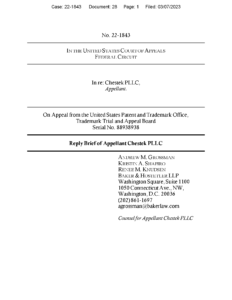The hamfistedness of USPTO’s efforts to force US trademark applicants to reveal where they sleep at night is striking. It is recalled that the USPTO claims that it needs to know where the US trademark applicant sleeps at night because it wants to smoke out any foreign applicant that might be using a post office box in the US to avoid having to hire US counsel. This justification collapses in those cases where, for example, the trademark application was filed by US counsel. But even in applications that were filed in the first place by US counsel, the USPTO persists in demanding that the applicant reveal to the USPTO where it sleeps at night.
During the first few years of this inquisitiveness by the USPTO into the sleeping habits of its applicants, the trigger for the inquiry was quite crude — it was the presence of the five letters “P O Box” in the address listed in the trademark application. This was an opening big enough to drive a truck through, for obvious reasons:
-
- The USPTO actively encourages its post office box customers to make use of the street address of the post office where the customer’s post office box is located, for example to facilitate package deliveries.
- The applicant might simply use a UPS Store or other private mailbox service.
During the first few years of this inquisitiveness by the USPTO into applicants’ sleeping habits, the USPTO routinely snoozed through many applications that made use of such applicant mailing addresses that avoided using the five letters “P O Box”. See for example my February 7, 2020 blog article The Commissioner for Trademarks definitely discards the CMRA data that it receives from the USPS and and my March 27, 2020 blog article Trademark Office misses a chance to demand that a trademark owner reveal where it sleeps at night and my July 31, 2021 blog article Let’s see if the Commissioner for Trademarks is now paying attention to CMRA information and my August 18, 2021 blog article Yes, the Trademark Office had a “comprehensive strategy” all along. That last blog article described how, in exasperation at the Commissioner’s being so inconsistent about this, I actually emailed to Commissioner Gooder a spreadsheet listing over two thousand trademark applications where a street address of a particular mail box rental service in Colorado Springs had been used instead of a post office box, and the Commissioner had snoozed through it.
But now after some three years, the USPTO has finally gotten around to making use of the CMRA information that it receives from the USPTO. Here is an example quoted from a recent Office Action:
In this case, the application lists applicant as a juristic entity and specifies applicant’s domicile address as follows: 6841 Elm Street, Unit 51, McLean, Virginia 22101. This address has been identified as a commercial mail receiving agency by the U.S. Postal Service Coding Accuracy Support System (CASS) and thus does not appear to be applicant’s headquarters where its senior executives or officers ordinarily direct and control the entity’s activities. See 37 C.F.R. §2.2(o)-(p); TMEP §601.01(b)(1). A commercial mail receiving agency is a private business that accepts mail from the U.S. Postal Service on behalf of third parties.
The USPTO raises this issue in the Office Action, of course, to try to smoke out the possibility that the applicant might be domiciled outside of the US and might have made use of a mailing address at a UPS Store or other similar service, instead of using a telltale post office box address, in an effort to avoid having to hire US counsel.
But anyway, yes, after some three years of receiving these suggestions, the Commissioner has now for the first time gotten around to making use of the CMRA database at the USPS to identify applications that make use of a post office’s street address to avoid the telltale “P O Box” letters, and to identify applications that make use of a UPS Store or similar private mailbox service. The practical consequence is that the Commissioner’s inquisitiveness into the sleeping habits of trademark applicants now casts a much wider net. Such inquisitiveness ought not to be necessary in cases filed by US attorneys, but it is there anyway.
It is not lost on me that I have been (and continue to be) a strong critic of this inquisitiveness on the part of the Commissioner, and yet as described above, I have been “giving aid and comfort to the enemy” by helping the Commissioner figure out how to cast a much wider net in this inquisitiveness into sleeping habits of trademark applicants. I guess in part I have been hoping that sooner or later the Examining Attorneys (whose workload in this area has probably doubled or tripled due to my having educated the Commissioner about this) would push back. I have been hoping that such pushback would prompt the Commissioner to use common sense and cease this “where does the applicant sleep at night” inquisitiveness at least in those cases where the applicant is already represented by US counsel. Nope. Common sense of this type seems to be in short supply.
It seems more than mere coincidence that this shift in the USPTO’s workflow happened only after these four blog articles were published, and only after I emailed to the Commissioner a spreadsheet listing over two thousand such examples. Of course I might have hoped that the Commissioner would do me the courtesy of acknowledging this, or even perhaps thanking me for the suggestions. Nope.


